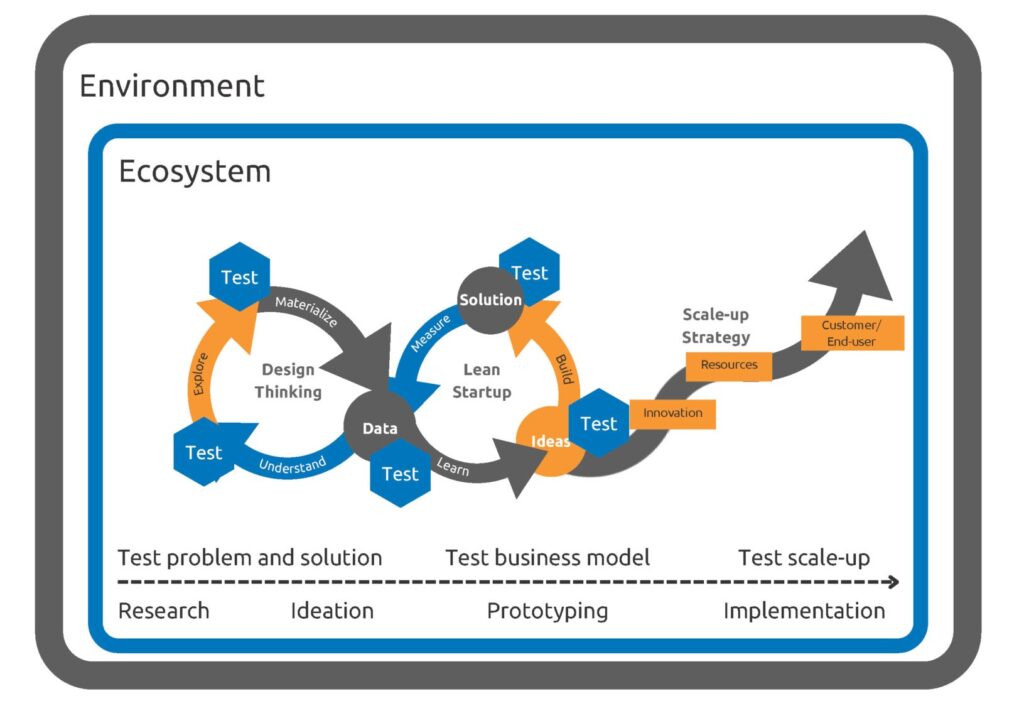Living Lab testing
& innovation scale-up playbook
INTRODUCTION
Health and care systems are facing major challenges as the world’s population ages rapidly. At the same time, digitalisation offers enormous opportunities to overcome these challenges and creates great business potential for the development of scalable Active and Healthy Ageing (AHA) innovations.
Creating scalable innovations and profitable business in the AHA field requires multidisciplinary collaboration of a wide range of stakeholders. One of the environments bringing stakeholders together is found in living labs, which can play an important role in assessing the relevance of innovations for the end-users.
The playbook offers guidance on how to test innovative AHA solutions in living labs and how to scale them up. Guidance is provided to start-ups but also for all parties interested in living lab testing and scaling up AHA innovations. The playbook includes tips and practical tools for self-assessment.
This video gives voices to elderly end-users, project experts, innovators, innovation advisors and funders, and discusses how living labs can help companies to test their solutions and scale them up. AHA is a huge market. There are various types of needs and older generations are increasingly used to embracing technology, but still, you must fulfil the criteria of a good business to get funding. To make your innovation scalable you must never be biased by your own environment. However, you must be aware of cultural and legislative differences in different countries.
You can find a complete version of the playbook here.
APPROACH
This playbook builds on two approaches which have become increasingly popular recently: design thinking and lean start-up. Both approaches are based on the idea that the co-creation of innovations with customers and end-users leads to better results. Moreover, it is important to ensure the involvement of all relevant stakeholders and to understand ecosystems.
- Design thinking builds on the learning process and collaborative development. The design thinking process is iterative.
- The lean start-up approach claims that the biggest waste is creating a product or service that nobody needs.
- For innovations and partnerships to emerge and grow in the health and care sector, an ecosystem is needed where people and organisations can get to know each other and experiment together.
The figure below illustrates how we integrated the approaches of design thinking, lean start-up, scaling up and ecosystems. Testing is a natural part of the process, and it should take place in each phase and after each step. All phases are carried out inside the ecosystem and wider environment and learning of this wider context accumulates from the beginning.
Further reading: You can find a complete version of the playbook in pdf here.
SUMMARY & CONCLUSIONS: THE BEST MODELS FOR INTERNATIONAL BUSINESS
The following remarks do not present coherent “models” for international business, but gather some principles that could help startups planning to scale up their AHA business into international markets. They are based on the learnings from the living lab testing and coaching process with the IN-4-AHA pilot companies.
Person-centred care – involving end-users
Many concepts fail because they do not solve an actual problem for the end-user. Those products or services are not desirable, and nobody will buy them. It has been shown that designs with a more person-centred approach have higher adoption rates and satisfaction among end-users. The potential customer or end-user must be involved in the innovation process from the beginning.
Involving all relevant stakeholders
The stakeholders of AHA solutions are not just elderly end-users, but the entire care circle, including family members, professionals, national, regional and local governments, healthcare and other service providers. All stakeholders should be involved to guarantee that the solution actually solves relevant problems and can be smoothly integrated into their systems.
Iteration and learning
The business, regulatory and technological environment is constantly changing. There are always new things to learn, which is why keeping an open mind and proceeding step by step is crucial.
Flexibility: preparing for bootstrapping and surprises
It has been claimed in the healthcare sector that the founders of a startup have to be prepared to support the company financially for many years before they are able to secure the first profitable deal. There are always surprises around the corner, and one must be prepared to take them as opportunities to learn and change direction (pivot).
Testing, testing, and testing
If we could offer just one take-away based on this playbook, it would be this: testing, testing, testing. Even testing of testing. Testing is necessary at all stages even though objectives and names vary.
Customer development: raising awareness and training
In the health and care sector, working closely with customers and end-users, and investing in raising awareness and training are often necessary because inflexible organisational structures and systems, among other factors, create barriers.
Relying on expertise
It is always wise to know oneself and one’s strengths, and be aware that no one knows everything. Therefore, experts should be involved in the development process as early as possible.
Market research – how to position the solution (blue ocean or red ocean)
Start-ups succeed only by placing the customer in the centre and by considering, at the same time, the right positioning of the solution on the market. Time should be dedicated to market and competitor research.
